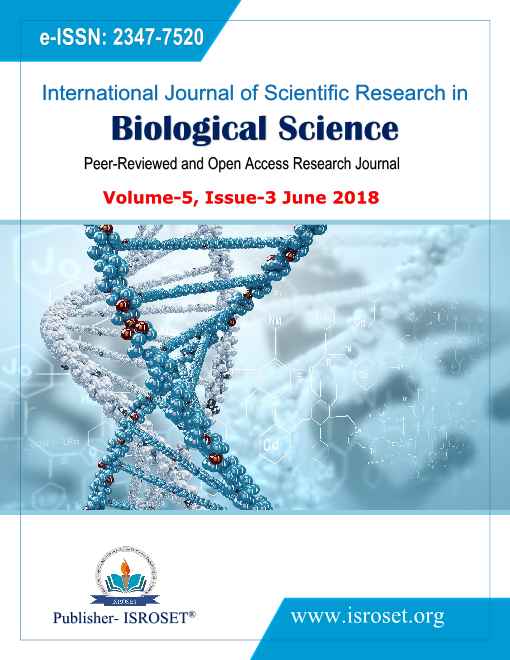Nutritional and Medicinal value of Moringa oleifera
Keywords:
Moringa oleifera, Cardiac, Drumsticks, Phenolics, StimulantsAbstract
Moringa oleifera Lam is a highly valued plant which is found in many countries of the tropics and subtropics. All the parts of this tree are useful either for nutritional or Medicinal purposes. Various parts of this plant such as the leaves, roots, seed, bark, fruit, flowers and immature pods act as cardiac and circulatory stimulants, possess antitumor, anti inflammatory, antihypertensive, cholesterol lowering and antifungal activities and are being employed for the treatment of different ailments in the indigenous system of medicine, particularly in South Asia. For cooking, usually leaves, flowers and Pods are used. They possess miraculous health benefits. Bark and roots are used in traditional medicines. This tree has small leaves, white flowers and seed pods which are long, slender and triangular resembling drumsticks so this tree is also known as Drumsticks in English. Different parts of Moringa oleifera contain important minerals and are a good source of proteins, vitamins, beta-carotene, amino acids and various phenolics. Moringa oleifera provides a rich and rare combination of zeatin, quercetin, beta-sitosterol, caffeoylquinic acid and kaempferol.
References
R.Dalla, “Food value of the lesser utilized tropical plant”, Food Chemistry, 46, 1993, 239-246
S.J. Stohs, M.J. Hartman “ Review of the Safety and Efficacy of Moringa oleifera”, Phytother Res. 2015 Jun; 29(6): 796-804.e-pub Mar 24, 2015
https://ndb.nal.usda.gov/ndb/foods/
N.Sharma, D.S. Rathore, “Antibacterial effects of Citrus limon peel extract on human pathogenic bacteria with special reference to Urinary Tract Infection”, IJSRBS,Vol.5, Issue.2, pp. 14-17, April (2018) E-ISSN: 2347-7520
S. Sugandha, “Callus Induction, Anti Microbial Screening and in Vitro Plantlet Regeneration of Adansonia Digitata L.: Anendangered Medicinal Tree”, IJSRBS, Vol. 2 issue 5, pp. 10-16, Oct (2015) E-ISSN: 2347-7520
R. Suresh,S.Thampiraj, and A. Stephen, “Antibacterial activities of wild rhizomatous plants - Curcuma aromatica, Curcuma longa (Zingiberaceae) and synergistic effects of both collected from southern Western Ghats, India”, IJSRBS, Vol. 5 issue 2, pp. 7-13, April(2018) E-ISSN: 2347-7520
H.R. Raveesha, T. Uthpala, “In vitro Callus Induction and Preliminary Phytochemical Studies of Cissampelos pareira L”, IJSRBS, Vol. 5 issue 1, pp. 12-17, Feb (2018) E-ISSN: 2347-7520
A. R. Verma, M. Vijayakumar, C.S.Mathela, “In vitro and in vivo antioxidant properties of different fractions of Moringa oleifera leave”, Food and Chemical Toxicology, Volume 47, Issue 9, September 2009, Pages 2196-2201
S.S Padma, “Antioxidant activity and total phenolic content of Moringa oleifera leaves two stages of maturity” Plant Foods Hum Nutr. 2009, Dec;64(4):303-11
R.L. Edwards, T. Lyon, S. E. Litwin, A.Rabovsky,J.D. Symons, Jalili, “Quercetin reduces blood pressure in hypertensive subjects”,JNutr. 2007 Nov;137(11): 2405-11.
N.K.Amaglo, “Profiling selected phytochemicals and nutrients in different tissues of the multipurpose tree Moringa oleifera L., grown in Ghana”, Food Chemistry Volume 122, Issue 4, 15 October 2010, Pages 1047-1054 https://doi.org/10.1016/j.foodchem.2010.03.
C. Waterman, “Isothiocyanate-rich Moringa oleifera extract reduces weight gain, insulin resistance, and hepatic gluconeogenesis in mice”, Mol Nutr Food Res. 2015 Jun;59(6):1013-24. doi: 10.1002/mnfr.201400679. Epub 2015 Apr 27.
S. Kushwaha, P. Chawla, A. Kochhar, “Effect of supplementation of drumstick (Moringa oleifera) and amaranth (Amaranthus tricolor) leaves powder on antioxidant profile and oxidative status among postmenopausal women”, Journal of Food Science and Technology November 2014, Volume 51, Issue 11, pp 3464–3469
M Mbikay, “ Therapeutic Potential of Moringa oleifera Leaves in Chronic Hyperglycemia and Dyslipidemia: A Review”, Front Pharmacol. 2012 Mar 1; 3:24. doi: 10.3389/fphar.2012.00024. eCollection 2012.
S.Charoensin, “Antioxidant and anticancer activities of Moringa oleifera leaves”, Journal of Medicinal Plant Research Vol. 8(7), pp. 318-325, 17 February, 2014 DOI: 10.5897/JMPR2013.5353 ISSN 1996-0875
Downloads
Published
How to Cite
Issue
Section
License

This work is licensed under a Creative Commons Attribution 4.0 International License.
Authors contributing to this journal agree to publish their articles under the Creative Commons Attribution 4.0 International License, allowing third parties to share their work (copy, distribute, transmit) and to adapt it, under the condition that the authors are given credit and that in the event of reuse or distribution, the terms of this license are made clear.







